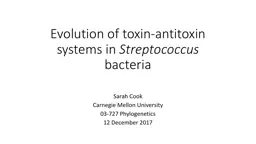

Streptococcus bacteria Sarah Cook Carnegie Mellon University 03727 Phylogenetics 12 December 2017 Toxinantitoxin TA system as abortive infection mechanism Abortive infection Abi mechanism ID: 780011
Download The PPT/PDF document "Evolution of toxin-antitoxin systems in" is the property of its rightful owner. Permission is granted to download and print the materials on this web site for personal, non-commercial use only, and to display it on your personal computer provided you do not modify the materials and that you retain all copyright notices contained in the materials. By downloading content from our website, you accept the terms of this agreement.
Slide1
Evolution of toxin-antitoxin systems in Streptococcus bacteria
Sarah Cook
Carnegie Mellon University
03-727
Phylogenetics
12 December 2017
Slide2Toxin-antitoxin (TA) system as abortive infection mechanism
Abortive infection (Abi) mechanism
Bacterial innate immunity
Phage infection resistanceResult in altruistic suicide of infected cell reduce phage progeny releaseDiscovering Abis that function as TA systemsPlasmid encodedAntitoxin gene located upstream of toxin geneAntitoxin necessary for cell survival
Slide3Motivation for Phylogenetic Analysis
Dy
et al. found type IV TA system in Streptococcus agalactiaeAbiEi (antitoxin) – transcriptional regulator AbiEii (toxin) – nucleotidyl transferase
Antic
et al.
studied strain differences in
Streptococcus pneumoniae
Observed two strains with 2 separate toxin genes
Slide4Project Aims
Do other
Streptococcus
bacteria have 2 different toxin (T) genes?Is there a similar pattern in the antitoxin (A) genes?Are the phylogenetic distributions of the T and A genes similar?How does the gene tree compare with the species tree?Are some species excluded? Are some groups excluded?
What evolutionary history best explains the distribution of TA genes?
Slide5Project Aims
Do other
Streptococcus
bacteria have 2 different toxin (T) genes?Is there a similar pattern in the antitoxin (A) genes?Are the phylogenetic distributions of the T and A genes similar?
How does the gene tree compare with the species tree?
Are some species excluded?
Are some groups excluded?
What evolutionary history best explains the distribution of TA genes?
Slide6Amino Acid Sequence Acquisition
To obtain toxin sequences:
BLAST with
S.agal sequence from Dy paperRef_seq and nr gave essentially the same sequence hitsFind a significant increase in E-value use the “drop off” sequence as query in a second search
Slide7Toxin Sequence Alignment
Aligned using
Jalview
Decided to use Mafft with accuracy-oriented presetTrees were the sameFewer gapsBetter alignment of conserved domains
Slide8Two distinct groups in toxin alignment
Slide9Project Aims
Do other
Streptococcus
bacteria have 2 different toxin (T) genes?Is there a similar pattern in the antitoxin (A) genes?
Are the phylogenetic distributions of the T and A genes similar?
How does the gene tree compare with the species tree?
Are some species excluded?
Are some groups excluded?
What evolutionary history best explains the distribution of TA genes?
Slide10Antitoxin Sequence Acquisition and Alignment
BLAST using B1599
S. pneumoniae
“A1” query sequenceUsed ref_seqExcluded S. pneumoniae Mafft (accuracy-oriented)
Slide11Two distinct groups in antitoxin alignment
Slide12Project Aims
Do other
Streptococcus
bacteria have 2 different toxin (T) genes?Is there a similar pattern in the antitoxin (A) genes?Are the phylogenetic distributions of the T and A genes similar?
How does the gene tree compare with the species tree?
Are some species excluded?
Are some groups excluded?
What evolutionary history best explains the distribution of TA genes?
Slide13Toxin model selection using
modelgenerator
http://
mcinerneylab.com
/software/
modelgenerator
/
Slide14Toxin tree (LG +G +F) in FigTree
Slide15Antitoxin model selection using model generator
Slide16Antitoxin tree (LG+G) in FigTree
Slide17Project Aims
Do other
Streptococcus
bacteria have 2 different toxin (T) genes?Is there a similar pattern in the antitoxin (A) genes?Are the phylogenetic distributions of the T and A genes similar?
How does the gene tree compare with the species tree?
Are some species excluded?
Are some groups excluded?
What evolutionary history best explains the distribution of TA genes?
Slide18Building a Species Tree
Richards
et al.
Genome
Biology and Evolution
. 2014;6(4):741-753.
Niu
et al.
Int
J
Syst
Evol
Microb
.
2014;6(4):741-753.
+
Slide19Species Tree in Notung
Slide20Toxin tree
Slide21Antitoxin
tree
Slide22Toxin gene tree after extreme manipulation
Rooting with transfers
cost of transfer = 9 to get feasible solution rearrange with threshold 0.70
reroot
with cost of transfer = 6
12 duplications and 7 transfers
Slide23Antitoxin gene tree after extreme manipulation
Rooting with transfers
cost of transfer = 9 to get feasible solution rearrange with threshold 0.95
reroot with cost of transfer = 8
4 duplications, 14 transfers, 36 losses
Slide24Future Directions
Different toxin sequence acquisition method
Include B1599/1598 sequences in alignment
Use tblastnInclude S.pneu in analysisFind T1/A1, T2/A2 from B1599 S.pneu
Are they always located next to each other? Constraint on gene tree
Slide25References
Richards VP, Palmer SR,
Pavinski
Bitar PD, et al. Phylogenomics and the Dynamic Genome Evolution of the Genus Streptococcus. Genome Biology and Evolution. 2014;6(4):741-753. doi:10.1093/
gbe
/evu048
.
Dy
RL,
Przybilski
R,
Semeijn
K, Salmond GPC,
Fineran
PC. A widespread bacteriophage abortive infection system functions through a Type IV toxin–antitoxin mechanism.
Nucleic Acids Research
. 2014;42(7):4590-4605. doi:10.1093/
nar
/gkt1419
.
Antic I, Brothers KM,
Stolzer
M, et al. Gene Acquisition by a Distinct Phyletic Group within
Streptococcus pneumoniae
Promotes Adhesion to the Ocular Epithelium.
Limbago
BM, ed.
mSphere
. 2017;2(5):e00213-17. doi:10.1128/mSphere.00213-17
.
Slide26Supplementary Information
Slide27Slide28